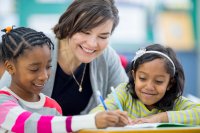Building a Strong Community of Young Learners
An elementary teacher reflects on what grief taught her about the value of social and emotional learning and seeing the whole child.
Your content has been saved!
Go to My Saved Content.Two weeks before the start of the 2015–16 school year, a dear friend of mine lost her 11-year-old boy to a bacterial brain infection. Ethan was a vivacious boy, and my heart broke with grief for my friend and her boy. Knowing that a parent’s worst fear had happened to a good friend, and could happen to me, left me splintered.
I had little energy or ability to manage that grief, but I was prepared to teach—I had taught second grade for years, so I let go of the reins and trusted myself.
Before that year, my teaching practice had reflected the U.S. culture of achievement-driven instruction. My focus was on getting my students to learn and grow as much as possible. I addressed their non-academic needs only in regard to how quickly I could get the focus back on learning. I thought this amounted to good teaching.
Seeing the Whole Child
Throughout that year of grief, one question was pivotal to shifting my mindset: Why bother with the myriad of pedagogical considerations if, in the process, I wasn’t really seeing the children, being present to their humanity and their experience as young people with whom I worked daily? Grief showed me that life is precious and my students are precious.
That question guided my teaching during that awful year. When a student was upset, I listened with no agenda of my own. I knelt down and looked them in the eye as I listened. If I learned the problem was pervasive and required a group discussion to problem-solve, that is what we did.
At times attending to their social and emotional needs delayed lessons or caused us to change course. Sometimes that meant the classroom structure and order loosened and kids engaged in off-task behavior more than I had allowed in the past. I learned more about what my students needed and used that to help them be more successful in their learning. The kids saw that I was invested in their well-being, and trusted me more.
Little by little this approach built a community of learners, a group of young people who had solid skills for coexisting. They were empathetic and accepting of differences, and had a strong sense of self, good listening skills, and an ability to express dissent productively.
The classroom may be a child’s first experience with a community beyond their family. It is where they learn civic literacy: how to solve conflict and why solving it matters, how to give and receive help, when to put themselves first and when to think of others.
In short, it’s where they learn how to be a citizen in a community. As we experience relationships in the classroom, we build the skills underlying civic literacy: listening to others, thinking critically, forming opinions, sharing ideas, and expressing dissent. All of these skills teach children how to actively and responsibly participate in a community.
The Value of Social and Emotional Learning
In 2014–15, our staff engaged in professional development in social and emotional learning (SEL) based on the book The Five Dimensions of Engaged Teaching. What I learned helped me as I worked to build a stronger classroom community after Ethan died. And I have built a community that gives me hope for the future, where I overhear kids say to each other, “I see you are sad. Want to come sit with me?”
I began opening the week with a sharing circle, where we bore witness to each others’ lives, practiced being active listeners, and learned to accept different perspectives. Each Friday we ended the week with a peace circle.
Another change I made this year was moving to a looser structure for the day. I used to rush the kids in the door in the morning and encourage them to eat breakfast quickly so we could settle into our work. Now when they walk in the door, we look each other in the eye, wish each other good morning, and welcome the day together. This practice gives me important information about the kids—in a matter of minutes I can gauge their emotional state.
During this time, I’m available to help them and to hear their news of the day. I used to transition the kids from one activity to another using a militant countdown, giving them little time to interact. I no longer expect the kids to move in unison—we transition from one activity to the next with music. Students move around the room and take brain-and-body breaks as needed. They know I expect responsible behavior around these freedoms, and that serves to maintain an atmosphere of learning.
With this looser classroom structure, the students have more opportunity to connect with and invest in each other.
Teachers work all year to create a classroom community where students feel safe and love to learn. We use a variety of strategies, like talk moves, cooperative learning structures, conflict resolution strategies, active listening, group work, and flexible seating. I believe SEL is the most powerful of these strategies.
Why do we work so hard create such a community? In the beginning, I did it because research shows that students learn better and take more risks when they feel safe. But now I do it because I’m working to create a world where we take the time to listen to each other and are willing to engage in the struggle of being human together. I aim to create a classroom that pulses with humanity.
